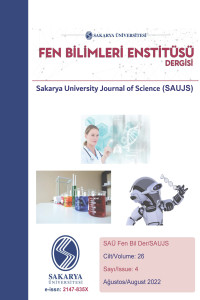Research Article
Global Existence and Uniqueness of The Inviscid Velocity-Vorticity Model of The g-Navier-Stokes Equations
Abstract
In this paper, we prove the global existence and uniqueness of the weak solutions to the inviscid velocity-vorticity model of the g-Navier-Stokes equations. The system is performed by entegrating the velocity-pressure system which is involved by using the rotational formulation of the nonlinearity and the vorticity equation for the g-Navier-Stokes equations without viscosity term. In this study we particularly interest the inviscid velocity-vorticity system of the g-Navier-Stokes equations over the two dimensional periodic box Ω=(0,1)^2⊂R^2.
Supporting Institution
-
Project Number
-
Thanks
-
References
- [1] M. Akbas, L. G. Rebholz, C. Zerfas, “Optimal vorticity accuracy in an efficient velocity-vorticity method for the 2D Navier-Stokes equations,” Calcolo, Vol. 55, no. 1, pp.1-29, 2018.
- [2] M. Gardner, A. Larios, L. G. Rebholz, D. Vargun, C. Zerfas, “Continuous data assimilation applied to a velocity-vorticity formulation of the 2D Navier-Stokes equations,” Electronic Research Archive, Vol. 29, no. 3, pp. 2223-2247, 2021.
- [3] T. B. Gatski, “Review of incompressible fluid flow computations using the vorticity-velocity formulation,” Applied Numerical Mathematics, Vol. 7, no. 3, pp. 227-239, 1991.
- [4] T. Heister, M. A. Olshanskii, L. G. Rebholz, “Unconditional long-time stability of a velocity- vorticity method for the 2D Navier-Stokes equations,” Numerische Mathematik, Vol. 135, no. 1, pp. 143-167, 2017.
- [5] A. Larios, Y. Pei, L. Rebholz, “Global well-posedness of the velocity-vorticity-Voigt model of the 3D Navier-Stokes equations,” Journal of Differential Equations, Vol. 266, no. 5, pp. 2435-2465, 2019.
- [6] Y. Pei, “Regularity and Convergence Results of the Velocity-Vorticity-Voigt Model of the 3D Boussinesq Equations,” Acta Applicandae Mathematicae, Vol. 176, no. 1, pp. 1-25, 2021.
- [7] Y. Cao, E. M. Lunasin, E. S. Titi, “Global well-posedness of the three-dimensional viscous and inviscid simplified Bardina turbulence models,” Communications in Mathematical Sciences, Vol. 4, no. 4, pp. 823-848, 2006.
- [8] A. Larios, E. S. Titi, “Higher-order global regularity of an inviscid Voigt-regularization of the three-dimensional inviscid resistive magnetohydrodynamic equations,” Journal of Mathematical Fluid Mechanics, Vol. 16 no.1, pp. 59-76, 2014.
- [9] J. Wu, “Viscous and inviscid magneto-hydrodynamics equations,” Journal d'analyse Mathematique, Vol. 73 no. 1, pp. 251-265, 1997.
- [10] Ö. Kazar, M. Kaya, “On the weak and strong solutions of the velocity-vorticity model of the g-Navier-Stokes equations,” (to appear).
- [11] J. Roh, “g-Navier-Stokes equations,” PhD, University of Minnesota, Minneapolis, MN, USA, 2001.
- [12] R. Temam, “Navier-Stokes equations, theory and numerical analysis,” American Mathematical Society, Chelsea Publication, Vol.343, pp. 161-163, pp. 252-290, 2001.
- [13] M. Schechter, “An Introduction to Nonlinear Analysis,” Cambridge University Press, 2004.
Year 2022,
Volume: 26 Issue: 4, 695 - 702, 31.08.2022
Abstract
Project Number
-
References
- [1] M. Akbas, L. G. Rebholz, C. Zerfas, “Optimal vorticity accuracy in an efficient velocity-vorticity method for the 2D Navier-Stokes equations,” Calcolo, Vol. 55, no. 1, pp.1-29, 2018.
- [2] M. Gardner, A. Larios, L. G. Rebholz, D. Vargun, C. Zerfas, “Continuous data assimilation applied to a velocity-vorticity formulation of the 2D Navier-Stokes equations,” Electronic Research Archive, Vol. 29, no. 3, pp. 2223-2247, 2021.
- [3] T. B. Gatski, “Review of incompressible fluid flow computations using the vorticity-velocity formulation,” Applied Numerical Mathematics, Vol. 7, no. 3, pp. 227-239, 1991.
- [4] T. Heister, M. A. Olshanskii, L. G. Rebholz, “Unconditional long-time stability of a velocity- vorticity method for the 2D Navier-Stokes equations,” Numerische Mathematik, Vol. 135, no. 1, pp. 143-167, 2017.
- [5] A. Larios, Y. Pei, L. Rebholz, “Global well-posedness of the velocity-vorticity-Voigt model of the 3D Navier-Stokes equations,” Journal of Differential Equations, Vol. 266, no. 5, pp. 2435-2465, 2019.
- [6] Y. Pei, “Regularity and Convergence Results of the Velocity-Vorticity-Voigt Model of the 3D Boussinesq Equations,” Acta Applicandae Mathematicae, Vol. 176, no. 1, pp. 1-25, 2021.
- [7] Y. Cao, E. M. Lunasin, E. S. Titi, “Global well-posedness of the three-dimensional viscous and inviscid simplified Bardina turbulence models,” Communications in Mathematical Sciences, Vol. 4, no. 4, pp. 823-848, 2006.
- [8] A. Larios, E. S. Titi, “Higher-order global regularity of an inviscid Voigt-regularization of the three-dimensional inviscid resistive magnetohydrodynamic equations,” Journal of Mathematical Fluid Mechanics, Vol. 16 no.1, pp. 59-76, 2014.
- [9] J. Wu, “Viscous and inviscid magneto-hydrodynamics equations,” Journal d'analyse Mathematique, Vol. 73 no. 1, pp. 251-265, 1997.
- [10] Ö. Kazar, M. Kaya, “On the weak and strong solutions of the velocity-vorticity model of the g-Navier-Stokes equations,” (to appear).
- [11] J. Roh, “g-Navier-Stokes equations,” PhD, University of Minnesota, Minneapolis, MN, USA, 2001.
- [12] R. Temam, “Navier-Stokes equations, theory and numerical analysis,” American Mathematical Society, Chelsea Publication, Vol.343, pp. 161-163, pp. 252-290, 2001.
- [13] M. Schechter, “An Introduction to Nonlinear Analysis,” Cambridge University Press, 2004.
There are 13 citations in total.
Details
| Primary Language | English |
|---|---|
| Subjects | Mathematical Sciences |
| Journal Section | Research Articles |
| Authors | |
| Project Number | - |
| Publication Date | August 31, 2022 |
| Submission Date | April 1, 2022 |
| Acceptance Date | May 30, 2022 |
| Published in Issue | Year 2022 Volume: 26 Issue: 4 |
Cite
INDEXING & ABSTRACTING & ARCHIVING
Bu eser Creative Commons Atıf-Ticari Olmayan 4.0 Uluslararası Lisans kapsamında lisanslanmıştır .


